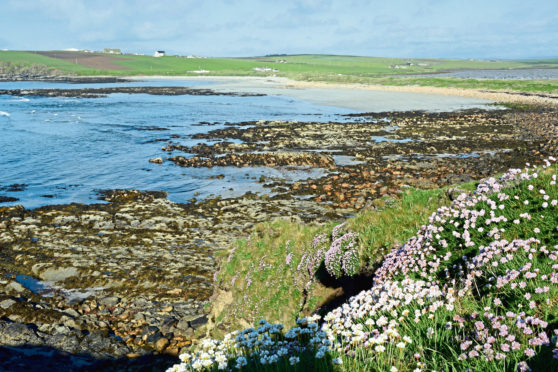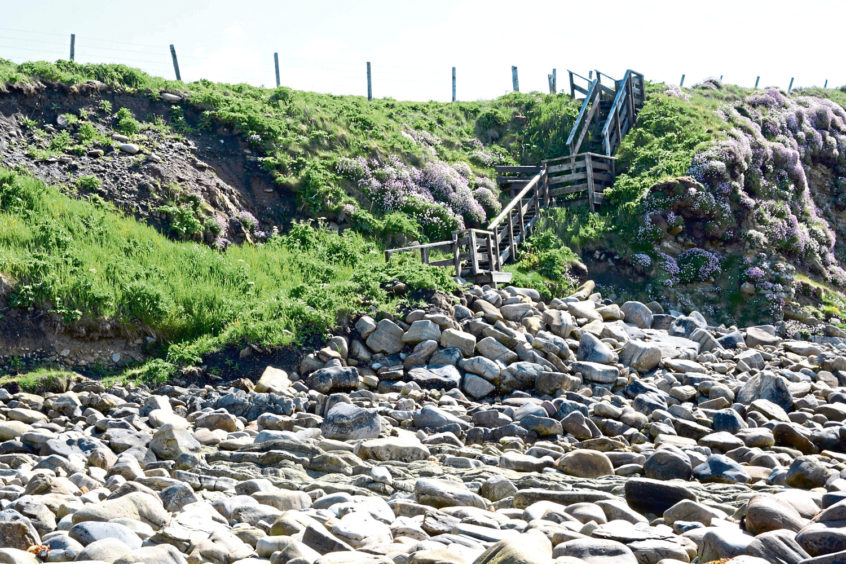If you want to appreciate the beautiful beaches of Orkney and enjoy the thrill of a cliff-top walk, this route could well be for you.
Don’t be fooled by the relatively short distance as there are plenty of challenges along the way.
And remember, it’s three and a half miles in one direction, making it a seven-mile round trip in total.
I started out at Dingieshowe, which is a rugged but lovely beach.
It is considered to be a real gem by Orcadians, and is rather bracing on a blustery day.
It also secures Deerness to the Mainland – just about!
Parking can be found at Sandi Sand, alongside toilet facilities.
In the first instance, take the A960 from Kirkwall.
It’s worth noting that this journey is also possible by bus, should you have arrived in Orkney as a foot passenger on the ferry.
From Sandi Sand, cross the dunes on to Dingieshowe and turn left along the beach.
While it is always wise to keep an eye on the tide times, you can still enjoy this walk if the tide is in.
Simply walk along the dunes, which is an entirely different experience to clambering along cliff-top paths.
You can pick up the track when the beach gives way to a rocky outline, where you’ll find a set of wooden steps.
Take care as these steps can be slippery when wet.
There is a bench around halfway up if you feel inclined to take a break.
A breather is worthwhile, as this vantage point offers views across the bay.
You may even be able to spot the broch mound at the end of the beach, from which Dingieshowe takes its name.
Once up the steps, there is a grassy path, so you can find firmer footing after clambering through the dunes.
The narrow path threads its way along the edge of the cliff, and is sandwiched between a fence and the cliff edge.
There are wooden barriers to keep you on track in the tightest parts, but watch your footing.
This is where good walking boots really pay off, and will enable you to keep your grip.
You can see out towards the uninhabited island of Copinsay, but the entire route is a feast for the eyes.
Copinsay is managed as a bird reserve, but there was once a flourishing community in existence.
A weekly postal service provided contact with the Mainland, but the island was abandoned as the population dwindled.
The cliffs are a riot of colour in the spring and summer, with sea birds nesting on the ledges.
You will pass Muckle Castle, but if you’re expecting turrets, think again.
All that is left to see is a mound of volcanic rock, although it is worth keeping a look out for the sea arch.
Although the beach around the castle is lovely, it is best to stick to the path as there is no safe means of descent.
You’ll also come across Peedie Castle, so named because it is a smaller pile of rock.
The Deerness slipway offers a lovely stop off before you make your way along the sands of Newark Bay.
The path drops on to a long sweep of sand and gives way to rocky shore, where you can rejoin the track.
As you cross a culvert via a wooden bridge, it’s worth pausing to enjoy the view both inland and out to sea.
The smell of seaweed can be quite strong, especially if the wind is blowing in a certain direction.
You’ll then find yourself on a farm track, and three wind turbines provide a handy marker.
Head for the picnic spot before crossing on to a track, which continues past the turbines to the Point of Ayre.
If you plan ahead, you can leave a bike at one end of the walk, or even a car if you enjoy the luxury of two vehicles.
While this route isn’t for the faint hearted, it is well worth the steep climb to enjoy some of the best views on the island.


